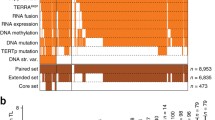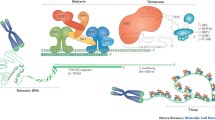Abstract
Telomere length is maintained by the enzyme, telomerase, which has been linked to cellular immortality and tumour progression. However, the reasons for the high levels of telomerase found in human tumours are unknown. We have mapped the human telomerase RNA gene, (hTR), to chromosome 3q26.3 and show the hTR gene to be amplified in four carcinomas, (2/33 cervix, 1/31 head and neck, 1/9 lung). In addition, increased copy numbers of the hTR locus was also observed in 97% of tumours. By in situ hybridisation, the histological distribution of high levels of hTR expression could be demonstrated in a lung tumour and its metastasis with hTR amplification. These results are the first report of genetic alterations involving a known component of telomerase in human cancer. Indeed, it is also the first report of the amplification of a specific locus within the chromosome 3q region frequently subject to copy number gains in human tumours. In addition, we also show for the first time the histological distribution of the RNA component of telomerase in human tumours.
Similar content being viewed by others
Author information
Authors and Affiliations
Rights and permissions
About this article
Cite this article
Soder, A., Hoare, S., Muir, S. et al. Amplification, increased dosage and in situ expression of the telomerase RNA gene in human cancer. Oncogene 14, 1013–1021 (1997). https://doi.org/10.1038/sj.onc.1201066
Received:
Revised:
Accepted:
Issue Date:
DOI: https://doi.org/10.1038/sj.onc.1201066
- Springer Nature Limited
Keywords
This article is cited by
-
Combining old and new concepts in targeting telomerase for cancer therapy: transient, immediate, complete and combinatory attack (TICCA)
Cancer Cell International (2023)
-
Non-canonical roles of canonical telomere binding proteins in cancers
Cellular and Molecular Life Sciences (2021)
-
Regulation of human telomerase in homeostasis and disease
Nature Reviews Molecular Cell Biology (2020)
-
Poly(A)-specific ribonuclease (PARN) mediates 3′-end maturation of the telomerase RNA component
Nature Genetics (2015)
-
Human telomerase RNA component (hTERC) gene amplification detected by FISH in precancerous lesions and carcinoma of the larynx
Diagnostic Pathology (2012)




